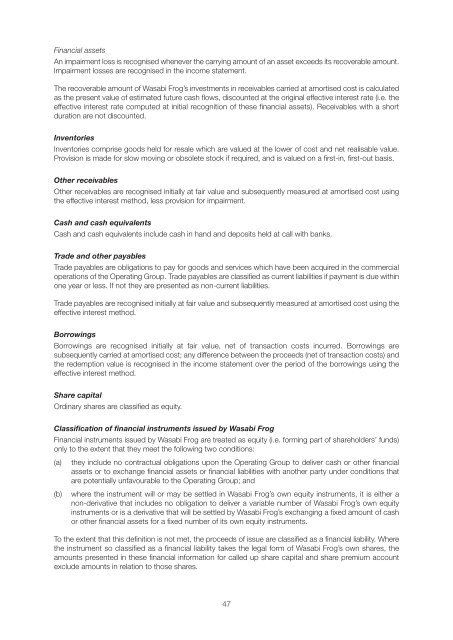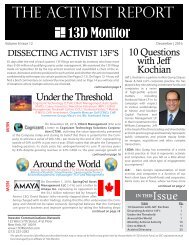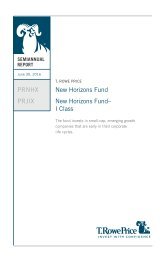boohoocom-plc-final-admission-document-5-march-2014
boohoocom-plc-final-admission-document-5-march-2014
boohoocom-plc-final-admission-document-5-march-2014
Create successful ePaper yourself
Turn your PDF publications into a flip-book with our unique Google optimized e-Paper software.
Financial assets<br />
An impairment loss is recognised whenever the carrying amount of an asset exceeds its recoverable amount.<br />
Impairment losses are recognised in the income statement.<br />
The recoverable amount of Wasabi Frog’s investments in receivables carried at amortised cost is calculated<br />
as the present value of estimated future cash flows, discounted at the original effective interest rate (i.e. the<br />
effective interest rate computed at initial recognition of these financial assets). Receivables with a short<br />
duration are not discounted.<br />
Inventories<br />
Inventories comprise goods held for resale which are valued at the lower of cost and net realisable value.<br />
Provision is made for slow moving or obsolete stock if required, and is valued on a first-in, first-out basis.<br />
Other receivables<br />
Other receivables are recognised initially at fair value and subsequently measured at amortised cost using<br />
the effective interest method, less provision for impairment.<br />
Cash and cash equivalents<br />
Cash and cash equivalents include cash in hand and deposits held at call with banks.<br />
Trade and other payables<br />
Trade payables are obligations to pay for goods and services which have been acquired in the commercial<br />
operations of the Operating Group. Trade payables are classified as current liabilities if payment is due within<br />
one year or less. If not they are presented as non-current liabilities.<br />
Trade payables are recognised initially at fair value and subsequently measured at amortised cost using the<br />
effective interest method.<br />
Borrowings<br />
Borrowings are recognised initially at fair value, net of transaction costs incurred. Borrowings are<br />
subsequently carried at amortised cost; any difference between the proceeds (net of transaction costs) and<br />
the redemption value is recognised in the income statement over the period of the borrowings using the<br />
effective interest method.<br />
Share capital<br />
Ordinary shares are classified as equity.<br />
Classification of financial instruments issued by Wasabi Frog<br />
Financial instruments issued by Wasabi Frog are treated as equity (i.e. forming part of shareholders’ funds)<br />
only to the extent that they meet the following two conditions:<br />
(a) they include no contractual obligations upon the Operating Group to deliver cash or other financial<br />
assets or to exchange financial assets or financial liabilities with another party under conditions that<br />
are potentially unfavourable to the Operating Group; and<br />
(b) where the instrument will or may be settled in Wasabi Frog’s own equity instruments, it is either a<br />
non-derivative that includes no obligation to deliver a variable number of Wasabi Frog’s own equity<br />
instruments or is a derivative that will be settled by Wasabi Frog’s exchanging a fixed amount of cash<br />
or other financial assets for a fixed number of its own equity instruments.<br />
To the extent that this definition is not met, the proceeds of issue are classified as a financial liability. Where<br />
the instrument so classified as a financial liability takes the legal form of Wasabi Frog’s own shares, the<br />
amounts presented in these financial information for called up share capital and share premium account<br />
exclude amounts in relation to those shares.<br />
47




